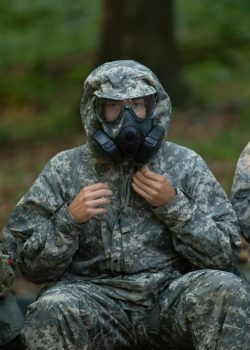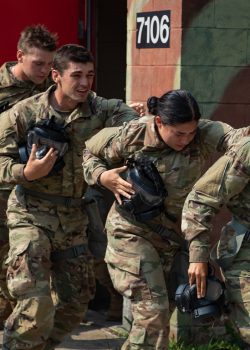
Cadets from 9th Regiment Advanced Camp attended chemistry class on July 21, 2021, except this time, the classroom was outdoors in the hot Kentucky summer, the professors were Cadre from across the U.S. Army, and the topic was CBRN: chemical, biological, radiological and nuclear training.
Starting off their morning, Cadets learned how to effectively react to these hazardous substances by donning their Mission Oriented Protective Posture (MOPP) gear in allotted timeframes. Most importantly, these future Army officers had to efficiently put their gas masks on in nine seconds or less.
“There is a possibility we could encounter it [CBRN] in the future,” said Gabe Coffelt, Kansas State University.
Not only does CBRN training prepare Cadets for the possibility of warfare involving poisonous gas, it also instills confidence in the equipment they are issued.
After completing the lessons, Cadets prepare for the most memorable portion of CBRN training—the confidence chamber.
In the confidence chamber, Cadets take off their protective gas masks to experience the effects of CS gas, commonly referred to as tear gas.

“It’s to actually test our equipment while in the chamber to make sure it works and functions well, and of course taking our masks off, building our confidence and testing our ability to get through anything that’s tough,” said Frank Mcguire, Virginia Tech.
Exposure to CS gas brings an unwelcomed burning sensation, tightness in the chest, coughing, and blurred vision, but even so, many Cadets were eager to experience it for themselves.
“I was pumped, I was ready to see what it felt like,” Mcguire joked. “The gas was nice and fresh when we got in there, so it was a great way to start the morning.”
Although the confidence chamber was challenging, Cadre helped keep Cadets energized from start to finish.
“Listen to your Cadre because their goal is to help you get through it as well,” suggested Coffelt.
Coming out of the chamber, Cadets are directed to flap their arms to generate the circulation of air around them and ease the effects of CS gas. It’s not exactly a pretty sight.
Both Coffelt and Mcguire laughed with their peers about the funny expressions on their faces.
“I would do it again,” said Coffelt.
After recovering from the CS gas and properly washing their gear, Cadets looked forward to lunch—class dismissed.




